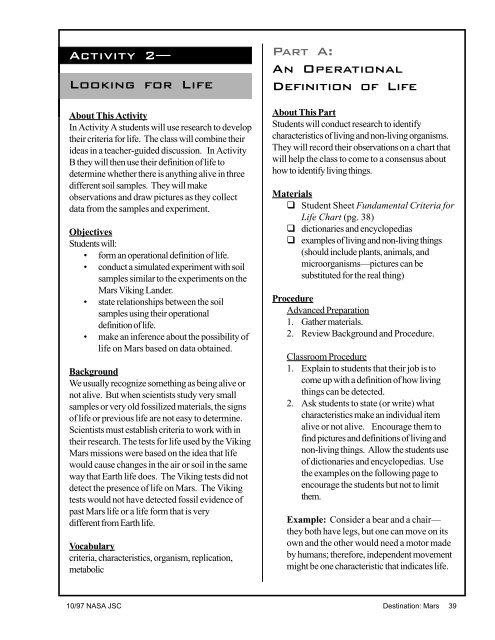Destination: Mars - ER - NASA
Destination: Mars - ER - NASA
Destination: Mars - ER - NASA
- No tags were found...
You also want an ePaper? Increase the reach of your titles
YUMPU automatically turns print PDFs into web optimized ePapers that Google loves.
Activity 2—Looking for LifeAbout This ActivityIn Activity A students will use research to developtheir criteria for life. The class will combine theirideas in a teacher-guided discussion. In ActivityB they will then use their definition of life todetermine whether there is anything alive in threedifferent soil samples. They will makeobservations and draw pictures as they collectdata from the samples and experiment.ObjectivesStudents will:• form an operational definition of life.• conduct a simulated experiment with soilsamples similar to the experiments on the<strong>Mars</strong> Viking Lander.• state relationships between the soilsamples using their operationaldefinition of life.• make an inference about the possibility oflife on <strong>Mars</strong> based on data obtained.BackgroundWe usually recognize something as being alive ornot alive. But when scientists study very smallsamples or very old fossilized materials, the signsof life or previous life are not easy to determine.Scientists must establish criteria to work with intheir research. The tests for life used by the Viking<strong>Mars</strong> missions were based on the idea that lifewould cause changes in the air or soil in the sameway that Earth life does. The Viking tests did notdetect the presence of life on <strong>Mars</strong>. The Vikingtests would not have detected fossil evidence ofpast <strong>Mars</strong> life or a life form that is verydifferent from Earth life.Vocabularycriteria, characteristics, organism, replication,metabolicPart A:An OperationalDefinition of LifeAbout This PartStudents will conduct research to identifycharacteristics of living and non-living organisms.They will record their observations on a chart thatwill help the class to come to a consensus abouthow to identify living things.Materialsq Student Sheet Fundamental Criteria forLife Chart (pg. 38)q dictionaries and encyclopediasq examples of living and non-living things(should include plants, animals, andmicroorganisms—pictures can besubstituted for the real thing)ProcedureAdvanced Preparation1. Gather materials.2. Review Background and Procedure.Classroom Procedure1. Explain to students that their job is tocome up with a definition of how livingthings can be detected.2. Ask students to state (or write) whatcharacteristics make an individual itemalive or not alive. Encourage them tofind pictures and definitions of living andnon-living things. Allow the students useof dictionaries and encyclopedias. Usethe examples on the following page toencourage the students but not to limitthem.Example: Consider a bear and a chair—they both have legs, but one can move on itsown and the other would need a motor madeby humans; therefore, independent movementmight be one characteristic that indicates life.10/97 <strong>NASA</strong> JSC <strong>Destination</strong>: <strong>Mars</strong> 39
















